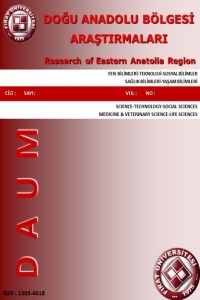APOPİTOZ VE YAŞLANMA
___
- 1. Abbas AK, Die and letlive. 1996. Eliminating dangerous lymphocytes. Cell. 84,655-8.
- 2. Anversa P, Hiler B, Ricci R, Guideri G, Olivetti G. 1986. Myocyte cell loss and myocyte hypertrophy in the aging rat heart. J Am Coll Cardiol. 8, 1441-8.
- 3. Ayaşlıoğlu E. 2001. Apopitoz. T Clin J Med Sci. 21, 57-62.
- 4. Chrest Fj, Buchholz MA, Kim Yh, Kwon TK, Nordin AA. 1995. Anti-CD3-induced apoptozis in T cells from young and old mice. Cytometry. 20,33-42.
- 5. Ekert PG, Vaux DL. Apoptosis and the immune system. 1997. Br Med Bull. 53, 591-603.
- 6. Higami Y, Shimokawa I. 2000. Apoptosis in the aging process. Cell Tissue Ress. 301, 125-32.
- 7. Hilbi H, Moss JE, Hersh D et al. 1998. Shigella induced apoptosis is dependent on caspase-1 which binds to IpaB Genomics. 51(1), 107-13.
- 8. Kajstura J, Cheng W, Sarangarajan R, et al. 1996. Necrotic and apoptotic Miocene cell death in the aging heart of Fischer 344 rats. Am J physiol Heart Circ Physiol. 271, 1215-28.
- 9. Kerr JFR, Wyllie AH, Currie AR. 1972. Apoptozis : a basic biological phenomenon with wide-ranging implications in tissue kinetics. Br J Cancer. 26, 239-57.
- 10. Masui T, Nakanishi H, Inada K, et. Al. 1997. Highly metastic hepatocellular carcinomas induced in male F344 rats treated with N-nitrosomorpholine in combination with other hepatocarcinogens show a high incidence of p53 gene mutations along with alterad mRNA ecpression of tumor related genes. Cancer Let.112, 33-45.
- 11. Mosoro EJ, 1995. Aging: current concept. In: Mssoro EJ Editor. Aging. New York: Oxford University Pres. 3-21.
- 12. Phaneuf S, Leeuwenburgh C. 2002. Cytochrome c release from mitokondria in the aging heart: a possible mechanism for apoptosis with age. Am J Physiol Regulatory Integrative Comp Phsiol. 423-30.
- 13. Raff MC, 1992. Social control on cell survival and cell death. Nature. 397-400.
- 14. Scaffidi C, Kirchhoff S, Krammer PH, Peter ME. 1999. Apoptozis signaling in lymphocytes. Curr Opin Immunol. 11, 277-85.
- 15. Thorngerry NA. 1997. The caspase family of cystein proteases. Br Med Bull. 53, 478-90.
- 16. Tsutsumi Y,Kamoshida S. 2003. Pitfalls and Caveats in Histochemically Demeonstrating Apoptozis. Acta Histochem. Cytochem.36 (4), 271-280.
- 17. Wyllie A. 1998. A tidy death. Odyssey. 4,47-52.
- 18. Yaraghi Z, Korneluk RG, MacKenzie A. 1999. Cloning and characterization of the multiple murine homologues of Naıp ( neuronal apoptozis inhibitory protein). J Clin Immunol. 19, 388-98.
- ISSN: 1303-4618
- Başlangıç: 2002
- Yayıncı: Fırat Üniversitesi
TÜRK SPOR EĞİTİMİNDE OPTİMUM VERİMİN ALINABİLMESİNİN ŞARTLARI
SALDIRGANLIĞIN PSİKOLOJİK-KÜLTÜREL BOYUTU VE VANDALİZM
Yener ÖZEN, Fikret GÜLAÇTI, Yahya ÇIKILI
KÖPEKLERDE ANAL KESE YANGILARININ SAĞALTIMINDA PROPOLİS EKSTRAKTININ KULLANIMI
Mehmet ÇEBİ, Murat ELİÖZ, Abdullah CANİKLİ, Murat KALDIRIMCI, Yonca Süreyya BİÇER, Cenk GÜRKAN
FİBER-MATRİKS ARAYÜZEYİNDE GERİLME ANALİZİ
SPORTİF AÇIDAN REKREASYON ETKİNLİKLERİNİN DEĞERLENDİRMESİ
Fikret RAMAZANOĞLU, Oğuzhan ALTUNGÜL, Arzu ÖZER
MUŞ BÖLGESİ FUTBOLCULARINI BU SPORA YÖNELTEN MOTİVASYONEL ETKENLERİN ARAŞTIRILMASI
Murat ELİÖZ, Murat KALDIRIMCI, Abdullah CANİKLİ, Yonca Süreyya BİÇER, Mehmet ÇEBİ, Cenk GÜRKAN
Mehmet ÇİFTÇİ, Bestami DALKILIÇ, Talat GÜLER, Osman Nihat ERTAŞ, Halil ÇERÇİ
